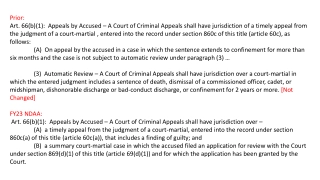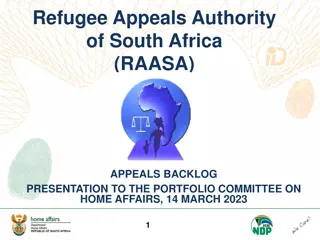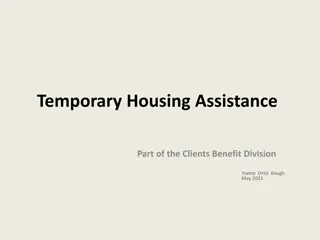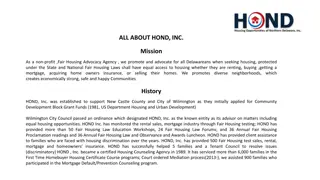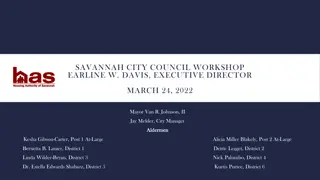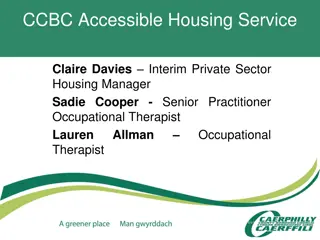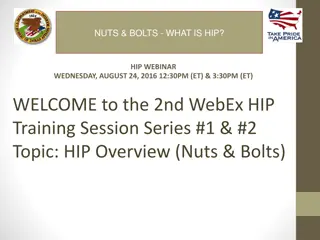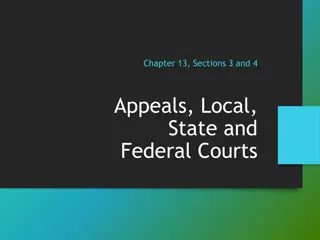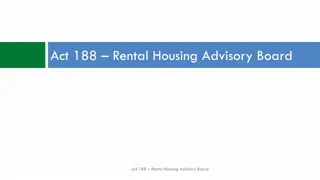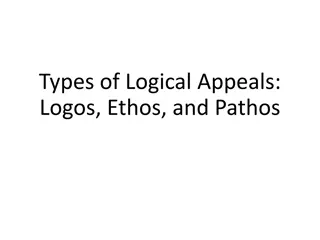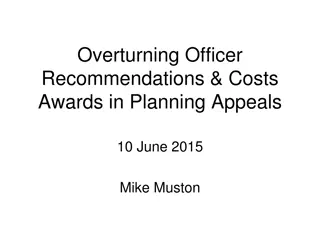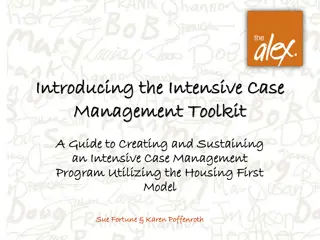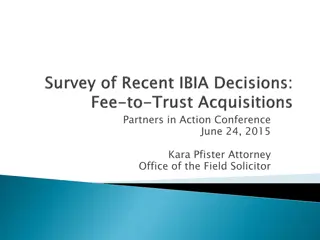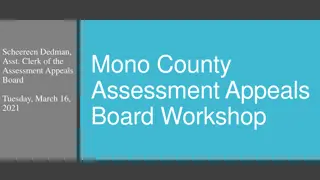Proposal for State Housing Appeals Board
Addressing resistance faced by housing developers, this proposal advocates the establishment of a state-level board to review local housing regulatory decisions. The Housing Appeals Board (HAB) aims to streamline the appeals process, reduce costs, and promote the development of affordable housing by offering an alternative to challenging local regulations in court.
Download Presentation

Please find below an Image/Link to download the presentation.
The content on the website is provided AS IS for your information and personal use only. It may not be sold, licensed, or shared on other websites without obtaining consent from the author.If you encounter any issues during the download, it is possible that the publisher has removed the file from their server.
You are allowed to download the files provided on this website for personal or commercial use, subject to the condition that they are used lawfully. All files are the property of their respective owners.
The content on the website is provided AS IS for your information and personal use only. It may not be sold, licensed, or shared on other websites without obtaining consent from the author.
E N D
Presentation Transcript
NASAL POYPS Dr.Satguru Saran Singh Assistant Professor Department of ENT
TYPES NASAL POLYPS ANTROCHOANAL POLYP BILATERAL ETHMOIDAL POLYP
ETI LOGY Inflammatory conditions of nasal mucosa Rhinosinusitis Disorders of ciliary motility Kartagener's syndrome Abnormal composition of nasal mucus Cystic fibrosis
ETI LOGY Various disease associated with the formation of nasal polyps are: Chronic rhinosinusitis Kartagener syndrome Cystic fibrosis Asthma Aspirin tolerance Allergic fungal sinusitis Young syndrome Churg-Strauss syndrome Nasal mastocytosis
PATH ESI Nasal mucosa becomes edematous due to collection of ECF polypoidal change Sessile to pedunculated (due to gravity and excessive sneezing)
PATH LOGY Early stage Nasal polyp (surface covered ciliated columnar epithelium) Metaplastic change in exposure to atmospheric irritation Transitional squamous epithelium large ICS filled with serous fluid Submucosa + infiltration with eosinophils and round cells
ITE I I ultiple nasal polyps always arise from the lateral wall of nose, usual from the middle meatus Common sites: Uncinateprocess Bulla ethmoidalis Ostia of sinuses Medial surface edge of middle turbinate
SYMPTOMS Mostly seen in adults Nasal stuffinessleading to total nasal obstruction Partial/total loss of smell Headache (associated sinusitis) Sneezing and watery nasal discharge (associated allergy) Protruding mass ,
SIGNS On anterior rhinoscopy, polyps appear as Smooth, glistening Grape-like masses Often pale in color May be sessile or pedunculated Insensitive to probing Do not bleed on touch Often multiple and bilateral Broadening of nose Increase intercanthal distance long standing case May protrude from the nostril and appear pink and vascular, simulating neoplasm Purulent discharge (associated sinusitis)
IAG OSI Clinical examination CT scan of paranasal sinuses exclude neoplasia plan surgery Histological examination especial in people >40 years
TREATM NT CONSERVATIVE Antihistaminics may revert early polypoidal changes with oedematous mucosa to normal control of allergy Short course steroids in people who cannot tolerate antihistaminics or with asthma
TREATM NT Polypectomy Intranasal ethmoidectomy Extranasal ethmoidectomy Transantral ethmoidectomy Endoscopic sinus surgery
SITE OF ORIGIN Arise from the mucosa of maxillary antrum near its accessory ostium, comes out of it, and grows in the choana a nasal cavity Thus, it has arts: 1. Antral: thin stalk 2. Choanal: round and globular 3. Nasal: flat from side to side I
ETI LOGY Exact cause is unknown Nasal allergy coupled with sinus infection is incriminated Seen in children and Usual single and unilateral adults
SYMPTOMS Unilateral nasal obstruction Bilateral nasal obstruction when polyp grows into the nasopharynx starts obstructing the opposite choana Thick and dull voice hyponasality Nasal discharge mostly mucoid
ON EXAMINATION Anterior rhinoscopy may be missed as it grows posteriorly Large, smooth, pale mass covered with nasal discharge Soft, can be moved up and down with theprobe, insensitive to touch and does not bleed on probing May protrude from nostril shows pink, congested loop
ON EXAMINATION Posterior rhinoscopy lar mass filling the choana or the nasopharynx A large polyp may hang down behind soft palate and present in oropharynx ......
INVESTIGATIONS Nasal endoscopy May reveal choanal or antrochoanal polyp hidden posteriorly in the nasal cavity Xrays of paranasal sinuses May show opacity of the involved antrum Lateral view globular swelling in postnasal space column of air behind the polyp
DIFFERENTIAL DIAGNOSIS 1. A blob of mucus disappear on blowing nose 2. Hypertrophied middle turbinate pink appearance hard feel of bone on probe testing 3. Angiofibroma history of profuse recurrent epistaxis firm in consistency easily bleed on touch 4. Neoplasms fleshy pink appearance friable nature tendency to bleed)
TREATM NT Avulsion nasal/oral route Recurrence is uncommon after complete removal In case of reccurence, Caldwell-Luc operation Complete removal of polyp from site of origin Endoscopic sinus surgery is now preferred
Common in children Age Common in adults Etiology Infection Allergy or multifocal Solitary Number Multiple Bilateral Laterality Unilateral Origin Ethmoidal sinuses Maxillary sinus near ostium Backwards to choana, may hang down behind soft palate Growth Mostly anteriorly & may present at the nares Size & shape Trilobed (antral, nasal, choanal part) Usually small & grape-like masses Recurrence Uncommon if removed completely Treatment Polypectomy, endoscopic removal Polypectomy, endoscopic surgery or ethmoidectomy


